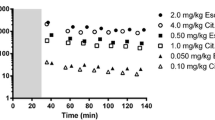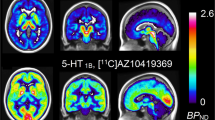Abstract
A characterization of [3H]ketanserin ([3H]KTS) binding in the frontal cortex (fCTX) and neostriatum (caudate-putamen, CPU) of rabbit was carried out to determine whether this ligand labels a non-serotoninergic receptor. The association and dissociation kinetics in fCTX were rapid, and could be fitted to two-site models, suggesting [3H]KTS is labeling two cortical sites. Using the serotonin-2 (5-HT2) antagonist mianserin to determine nonspecific binding, the saturation curves revealed a single high-affinity binding site. In contrast, when unlabeled ketanserin was used for nonspecific counts, the Scatchard plots were best fitted to a two-site model but the binding parameters of the high-affinity site were similar to that obtained in the presence of mianserin. The 5-HT2 antagonists mianserin, methysergide and ritanserin inhibited [3H]KTS binding in fCTX at nanomolar concentrations, however, the curves were best fitted to two-site models. In contrast, [3H]KTS binding to membrane preparations from the CPU could only be inhibited by high (micromolar) concentrations of these antagonists. Low micromolar concentrations of the monoamine uptake blockers GBR12909, desipramine, nomifensine, cocaine and fluoxetine competed with [3H]KTS in both fCTX and CPU. This study demonstrates that [3H]KTS labels a non-serotoninergic recognition site in the rabbit fCTX and CPU similar to that found in the rat neostriatum, i.e.: probably a monoamine transport site.
Similar content being viewed by others
References
Leysen, J. E., Niemegeers, C. J. E., van Nueten, J. M., and Laduron, P. M. 1982. [3H]Ketanserin (R41 468), a selective3H-ligand for serotonin2 receptor binding sites. Mol. Pharmacol. 21:301–314.
Pazos, A., Cortés, R., and Palacios, J. M. 1985. Quantitative autoradiographic mapping of serotonin receptors in the rat brain. II. Serotonin-2 receptors. Brain Res. 346:231–249.
Leysen, J. E., Eens, A., Gommeren, W., van Gompel, P., Wynants, J., and Janssen, P. A. 1988. Identification of non-serotoninergic [3H]ketanserin binding sites associated with nerve terminals in rat brain and platelets; relation with release of biogenic amine metabolites induced by ketanserin-and tetrabenazine-like drugs. J. Pharmacol. Exp. Ther. 244:310–321.
Roth, B. L., McLean, S., Zhu, X.-Z., and Chuang, D.-M. 1987. Characterization of two [3H]ketanserin recognition sites in rat striatum. J. Neurochem. 49:1833–1838.
Lindvall, O., and Björklund, A. 1984. General organization of cortical monoamine systems. In: Monoamine Innervation of Cerebral Cortex (Eds. Descarries, L., Reader, T. A., and Jasper, H. H.), pp. 9–40. Alan R. Liss, New York.
Reader, T. A., Dewar, K. M., and Grondin, L. 1989. Distribution of monoamines and metabolites, in rabbit neostriatum, hippocampus and cortex. Brain Res. Bull. 23:237–247.
Reader, T. A., and Dewar, K. M. 1989. Endogenous homovanillic acid levels differ between rat and rabbit caudate, hippocampus and cortical regions. Neurochem. Res. 14:1137–1141.
Rose, M. 1931. Cytoarchitektonischer Atlas des Grosshirnrindes des Kaninchens. J. Psychol. Neurol. (Lpz.) 43:353–440.
Lowry, O. H., Rosebrough, N. J., Farr, A. L., and Randall, R. J. 1951. Protein measurements with Folin phenol reagent. J. Biol. Chem. 193:265–275.
McPherson, G. A. 1985. Analysis of radioligand binding experiments: A collection of computer programs for the IBM PC. J. Pharmacol. Methods 14:213–228.
Munson, P. J., and Rodbard, D. 1980. LIGAND: A versatile computerized approach for characterization of ligand-binding systems. Ann. Biochem. 107:220–239.
Barlow, R. B. 1983. Biodata Handling with Microcomputers, pp. 125–143, Elsevier Science Publishers, Amsterdam.
Hoyer, D., Vos, P., Closse, A., Pazos, A., Palacios, J. M., and Davies, H. 1987. [3H]Ketanserin labels 5-HT2 receptors and α1 in human and pig brain membranes. Naunyn-Schmiedeberg's Arch. Pharmacol. 335:226–230.
O'Dell, S. J., and Marshall, J. F. 1988. Autoradiographic localization of distinct serotonergic and non serotonergic [3H]ketanserin binding sites. Soc. Neurosci. Abs. 14:778.
Peroutka, S. J., Hamik, A., Harrington M. A., Hoffman, A. J., Mathis, C. A., Pierce, P. A., and Wang, S. S. H. 1988. R(−)[77Br]4-Bromo-2,5-dimethoxyamphetamine labels a novel 5-hydroxytryptamine binding site in brain membranes. Mol. Pharmacol. 34:537–542.
Pierce, P. A., and Peroutka, S. J. 1989. Evidence for distinct 5-hydroxytryptamine2 binding site subtypes in cortical membrane preparations. J. Neurochem. 52:656–658.
Author information
Authors and Affiliations
Rights and permissions
About this article
Cite this article
Dewar, K.M., Lima, L. & Reader, T.A. [3H] Ketanserin binds to non-5-HT2 sites in rabbit cerebral cortex and neostriatum. Neurochem Res 15, 507–514 (1990). https://doi.org/10.1007/BF00966208
Accepted:
Issue Date:
DOI: https://doi.org/10.1007/BF00966208




